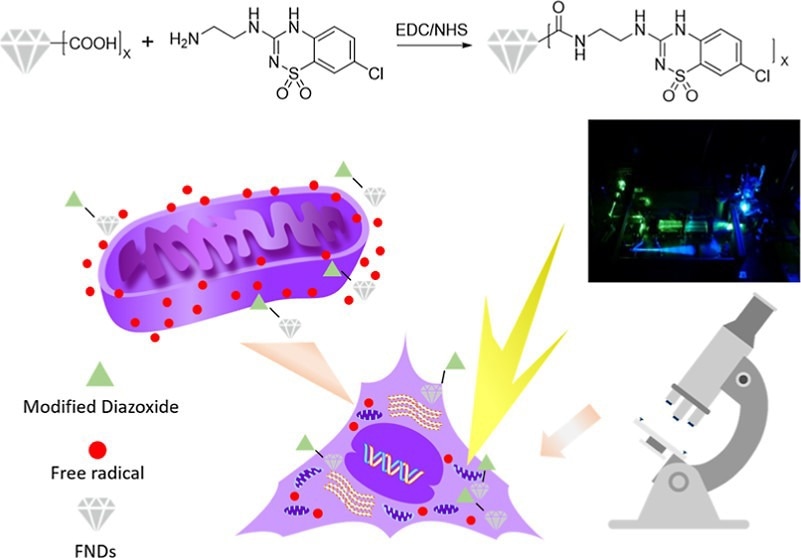Fluorescent nanodiamonds have unique optical and chemical properties and were individually applied as nanocarriers for drug delivery and free radical quantum sensors. An article published in the journal ACS Applied Materials and Interfaces presented multifunctional fluorescent nanodiamonds for drug delivery and real-time detection of free radicals.

Study: Functionalized Fluorescent Nanodiamonds for Simultaneous Drug Delivery and Quantum Sensing in HeLa Cells. Image Credit: Tian, Y et al. (2022)
The fluorescent nanodiamonds with nitrogen vacancy (NV) centers were modified with a diazoxide derivative, facilitating their easy entry into cells and delivering cancer drugs into HeLa cells. The developed fluorescent nanodiamonds were characterized using infrared (IR) spectroscopy, dynamic light scattering (DLS), and secondary electron microscopy.
Compared to the free drug with drug release in 12 hours, the fluorescent nanodiamonds functionalized with drug molecules exhibited sustained drug release for over 72 hours. In addition to drug release, these fluorescent nanodiamonds also measured the effects of the drug on free radical generation locally.
The optical properties of fluorescent nanodiamonds changed based on the magnetic surrounding. The relaxometry technique was applied to detect the free radical’s spin noise at the nanoscale level with subcellular resolution. Thus, the present work offered a new strategy to explore the relationship between drug release and cell response based on radical formation.
Applications of Fluorescent Nanodiamonds
Fluorescent nanodiamonds have the advantage of lower toxicity, exceptional chemical stability, better photostability, and can be surface functionalized by techniques like those used for other nanoparticles. They are ingested naturally by different cell types via endocytosis pathways.
Although the core of fluorescent nanodiamonds is inert, its rich surface chemistry is leveraged to attach different drugs. The photostability of fluorescent nanodiamonds restrains their bleaching and can be observed via fluorescence emission, used in biodistribution studies.
Besides drug delivery, the optical properties and photostability of fluorescent nanodiamonds extend their applications in long-term optical imaging. Moreover, due to the visibility of fluorescent nanodiamonds through different imaging techniques, they are also applied as labels for correlative microscopy.
The NV centers in fluorescent nanodiamonds sense the magnetic resonances optically by tuning their fluorescence in response to the magnetic surrounding. Additionally, ultrasensitive fluorescent nanodiamonds can help detect even a single electron or a few nuclear spins.
The presence of free radicals in cells can damage the proteins, nucleic acids, and lipids, leading to cancer, cardiovascular diseases, and bacterial or viral infection. Thus, tracking the free radicals is critical to monitoring the health status of cells. Utilizing fluorescent probes is a common approach to measuring free radicals. Here, the fluorescent probes react with free radicals and form fluorescent compounds. However, this method lacks long-term observation due to the bleaching of the fluorescent compounds.
Functionalized Fluorescent Nanodiamonds as Drug Carriers
While fluorescent nanodiamonds were individually reported as nanocarriers and free radical quantum sensors, there are no reports that combined both these functions. This dual functioning of fluorescent nanodiamonds enables simultaneous drug delivery and analyses of the cell response to the drug.
Thus, the present work aimed to develop fluorescent nanodiamond-diazoxide complexes as drug carriers. The diazoxide drug influences the potassium (K+) channels in mitochondria, obstructing the release of free radicals and increasing the insulin level to inhibit cancer growth.
Amination of diazoxide promoted its reactivity towards the carboxyl group on the fluorescent nanodiamond surface without altering its inherent functionality. Thus, the prepared fluorescent nanoreactor-diazoxide composite systems that entered the cell were located in real-time and monitored for the changes in concentration of free radicals inside cells.
The drug release characteristics in vitro showed the cumulative drug release, wherein the fluorescent nanodiamonds mixed with the drug and those covalently attached were compared. While the mixture of fluorescent nanodiamonds and drug showed a quick drug release, the composite systems showed a sustainable release of 100% of the drug within 72 hours, increasing the circulation time of the drug in the bloodstream and ensuring its bioavailability in the tumors.
In addition, the common drawback of drug elimination by tumors was overcome through the present strategy, wherein the cleavage of the amide bond of the fluorescent nanodiamond- diazoxide composite system was accelerated by the acidic environment in endosomes which is the primary location of nanodiamond entry and residence. Consequently, the surrounding healthy cells had lower toxicity.
Conclusion
To summarize, the developed diazoxide functionalized fluorescent nanodiamonds delivered the diazoxide derivatives into HeLa cells. These modified fluorescent nanodiamonds showed sustained drug release compared to the free drugs. Thus, the present approach allowed for tracking the fluorescent nanodiamonds and evaluating the drug response at the site of drug release.
Furthermore, free radical detection was achieved with the help of fluorescent nanodiamond quantum sensing abilities. Additionally, the photostability of fluorescent nanodiamonds facilitated the long-term tracking of particles throughout the release experiment. Thus, the present work offered a robust tool for delivering the drug molecules and measuring their effect in cells locally.
Reference
Tian, Y et al. (2022). Functionalized Fluorescent Nanodiamonds for Simultaneous Drug Delivery and Quantum Sensing in HeLa Cells. ACS Applied Materials and Interfaces. https://pubs.acs.org/doi/10.1021/acsami.2c11688
Disclaimer: The views expressed here are those of the author expressed in their private capacity and do not necessarily represent the views of AZoM.com Limited T/A AZoNetwork the owner and operator of this website. This disclaimer forms part of the Terms and conditions of use of this website.